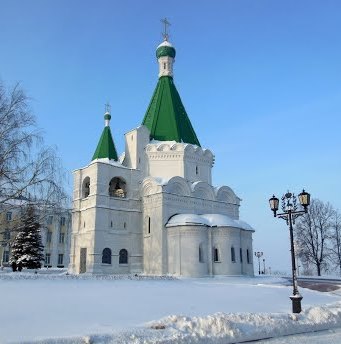

The Cathedral of the Archangel Michael is one of the oldest and most significant churches in Nizhny Novgorod, located within the Nizhny Novgorod Kremlin. It is a monument to 17th-century tented-roof architecture and the oldest surviving stone structure in the city. The cathedral is dedicated to the Archangel Michael, the patron saint of the Russian military. Below, I will describe in detail its history, architecture, interior, burial sites, and significance.
The cathedral traces its history back to the founding of Nizhny
Novgorod in 1221 by Grand Prince Yuri Vsevolodovich. According to
legend, the prince founded a wooden church in honor of the Archangel
Michael on the very site where the cathedral stands today. A Russian
chronicler noted that the prince "founded a city at the mouth of the
river, naming it Nizhny Novgorod, and erected a wooden church in it
dedicated to the Archangel Michael." As early as 1227, the church was
rebuilt in stone, becoming a four-pillar, three-apse white-stone
cathedral.
In the 14th century, when Nizhny Novgorod became the
capital of the Nizhny Novgorod-Suzdal Principality (1341–1392), the
cathedral repeatedly burned and fell into disrepair. In 1359, it was
rebuilt and became the prince's burial vault. The city and the cathedral
suffered during the Mongol invasion in the 14th century, after which the
cathedral lay in ruins for a long time, but continued to be used as a
burial place for the princely family.
After the victory of the Nizhny
Novgorod militia in 1612, when Kuzma Minin addressed the townspeople at
the cathedral's walls, calling for the liberation of Moscow from the
Polish-Lithuanian invaders, a spiritual upsurge occurred in Russia. In
December 1627, a decree was issued authorizing the construction of a new
stone cathedral at the expense of the state treasury. Work was carried
out from 1628 to 1631 under the supervision of stonemason Lavrenty
Semyonovich Vozoulin and his stepson Antipa Konstantinov. This building
survives to this day.
In 1703, the cathedral was damaged by fire and
restored. In the 1920s, after the revolution, the cathedral was closed,
and in 1962, it became a branch of the historical museum. That same
year, the remains of Kuzma Minin were transferred here from the
destroyed Transfiguration Cathedral. In 1991, the cathedral was returned
to the Russian Orthodox Church, and services resumed. Today, it is a
functioning church of the Nizhny Novgorod Diocese.
The cathedral is built in the tented roof style, typical of
17th-century Russian architecture, and is an outstanding architectural
monument of the 13th-17th centuries, forming part of the Kremlin
complex. The building is constructed of white stone with green roofs,
giving it a light and graceful appearance. Its main decoration is the
central supporting tent, tall and graceful, crowned with a gilded cross.
The tent rests on an octagonal drum with rows of kokoshniks (decorative
arches) at the base.
On the eastern side are three apses
(semicircular projections for the altar). A tented bell tower is
attached to the western side, integrated with the church, a unique
architectural feature: the bell tower and church form a single unit. The
entrance portal is designed as a porch with arched openings. The
cathedral's overall dimensions are compact: it is not particularly
large, but fits harmoniously into the Kremlin landscape. The facades are
decorated with semi-columns, cornices, and arched windows typical of
Russian Baroque with elements of the Old Russian style.
The cathedral
is the only ancient church remaining within the Kremlin and is
considered the oldest stone structure in Nizhny Novgorod.
The cathedral's interior is characterized by asceticism and
austerity, emphasizing its historical role as a princely burial vault.
The walls are not decorated with frescoes, and the lighting is rather
dim, creating an atmosphere of solemn gloom appropriate for a burial
site. The names of members of the princely family are carved into the
niches (arcosolia) of the western wall—memorial inscriptions indicating
burials.
The main relic of the interior is the tombstone of Kuzma
Minin. The iconostasis is modest but harmonious, with icons in the
traditional Russian style. The floors and walls retain an authentic
appearance, without excessive decorativeness. During archaeological
excavations in the 1960s, ancient burials were found under the floor and
next to the cathedral, confirming its historical role.
The cathedral has long served as a burial place for the Nizhny
Novgorod princes and their families. The following are buried here:
Prince Vasily Semyonovich Kirdyapa (d. 1404);
Prince Ivan
Vasilyevich (d. 1416);
The last Grand Duke of Nizhny Novgorod, Vasily
Yuryevich (d. 1450);
Members of their families.
The burial
sites are not precisely known, but are marked by inscriptions in the
arcosolia of the western wall. Some remains were found during
excavations in the 1960s under the cathedral's floor.
Since 1962, the
cathedral has housed the remains of Kuzma Minin, a hero of the Nizhny
Novgorod militia of 1612. He was originally buried in the
Transfiguration Cathedral, but was moved here after its destruction. The
burials emphasize the cathedral's connection to Russian history and
military glory.
The Archangel Michael Cathedral is a symbol of the founding of Nizhny
Novgorod and its military history. It is associated with national heroes
such as Kuzma Minin and is considered the first monument to the Nizhny
Novgorod militia. As part of the Kremlin, the cathedral is listed as a
cultural heritage site of Russia and attracts tourists and pilgrims.
Today, the cathedral is active: the altar is consecrated in honor of
the Archangel Michael and other Bodiless Powers of Heaven (feast day:
November 21). Services are held regularly. Address: Nizhny Novgorod,
Kremlin. Visiting the cathedral is free, but it is recommended to
observe the rules of conduct in an active church.